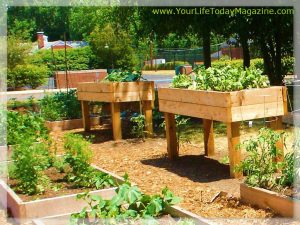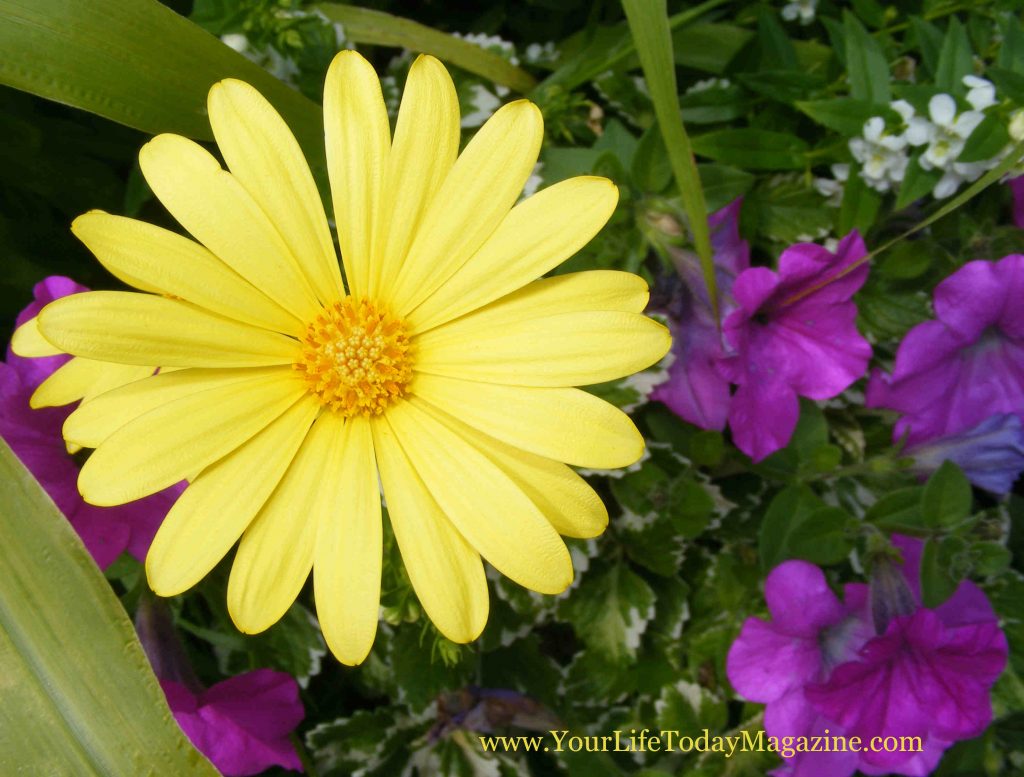- For instant color and interest in your yard, place small garden flags, painted chairs or benches, a table with a floral tablecloth and attractive garden art in strategic locations. Relax on one of the chairs while you plan the rest of your garden.
- Remember it doesn’t all have to be done at once! Create your garden a few plants at a time over the course of months or years as you have the energy. Start with the most visible areas first. I like to select areas that are not only visible from the street, but also from windows that I often look through so I can enjoy the flowers even when I can’t make it outside.
- Choose an area that is easy to water. Avoid putting your garden or flower bed farther away than you can reach with a hose or two linked together. Watering cans are pretty, but they get heavy and are tiring to fill and carry back and forth enough to get a sufficient amount of water to your thirsty plants.
- Sprinklers with timers (or if you have good water pressure, seepers) can be useful. Note: If you have trouble with movement or pain, choose lightweight hoses. They kink more easily than the thicker ones, but they are much easier to tote around as needed.
- Before selecting plants, pay attention to how much sun your proposed planting area gets throughout the day. Then choose plants that thrive in that amount of light. (Full Sun, Part Sun/Part Shade, Full Shade)
- Buy a roll of weed matting. A few extra minutes to place it before for you plant will save you hours of weeding in the months to come. Rolls made of brown recycled paper are much easier to cut than the weed cloth and blend better with surrounding dirt. Top with mulch to help retain moisture and cover the paper.
- Perennial plants come back every year, so digging once to plant perennials in your flower bed or border will give you years of enjoyment. Consult your local garden center for suggestions for your climate. Popular low-maintenance ones that do well in sunny spots include daylilies, salvia or sage, lavender, tulips, daffodils, hyacinths, lilies and irises. (Some roses are also easy to grow.) Pansies also come back year after year in some climates, but in others they need to be treated as annuals. Shade-loving perennials include feather-like astilbes, Jacob’s ladder, coral bells and hostas.
- Pay attention to what professional landscapers have planted on commercial properties in your region. Chances are they’ve selected low-maintenance perennials that thrive in your climate since they can’t be there every day to coddle each plant.
- While many perennials usually bloom only once or twice a season and then store up energy for the following year, annuals often bloom the whole season since this is their only chance to shine.
- Annuals are great choices for high impact locations like hanging plants and planters near your entry-way. Choosing raised locations for annuals makes them more visible and saves bending. Wave petunias are an excellent choice for sunny spots. Impatiens and begonias do well in shadier locations. Vinca vines trailing from the pots add visual interest and work well in sunny or shady places.
- Remember to water plants in pots and planters every day since they dry out much more quickly than those planted in the ground.
- Knee pads are great when kneeling is necessary.
- A tulip auger is an inexpensive tool that attaches to most household drills and can be used to drill holes to plant not only tulip bulbs but other plants as well. For larger plants, re-drill the hole along the sides to expand the hole.
- Good gardening gloves are priceless! The pretty thin cotton ones are nice if you’re working on houseplants, but useless against the thorns, stingers and blisters typical of outdoor gardening. Try to get some with leather or at least sturdy canvas palms with a lightweight material for the back of the hand. Heavy-duty suede gloves are nice but can get hot in the summer. Work gloves can wear out quickly, so if you find a kind you like, buy several pairs at once.
- Vertical wall gardens can be a very attractive feature in your garden that also happen to be easily accessible.
- Building a raised bed can be a daunting task if you suffer from pain and weakness, but if you can have someone build one for you it can make things much easier. Wheelchair users can have them built so that they are a convenient height and depth so that all parts of the bed can be accessed from a seated position.
- Raised beds that allow for leg room underneath like a table are especially nice. Modifying an existing table could be an option if you have to build it yourself. Even simply placing a number of planters on a table outside can instantly give you many of the advantages of a raised bed. As the old saying goes, “Where there is a will, there is a way.”

